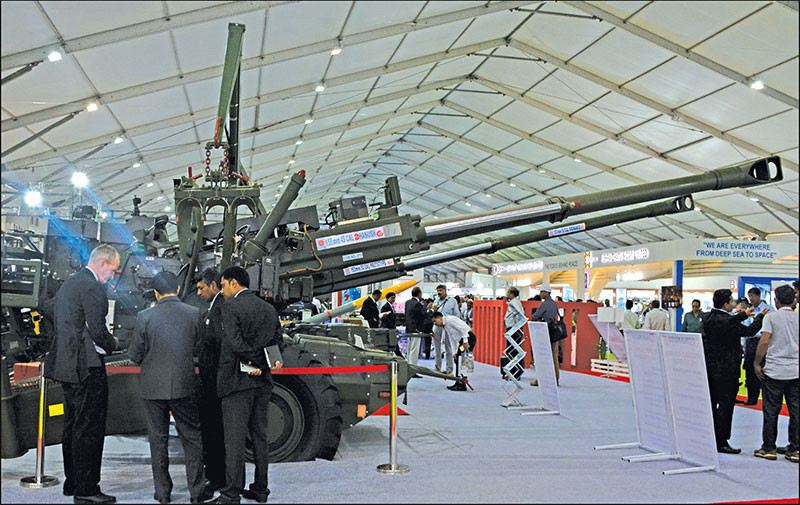The made in India Dhanush is a step forward in achieving self-sufficiency
 Lt Gen. Rameshwar Yadav (retd)
Lt Gen. Rameshwar Yadav (retd)
The induction of Dhanush artillery gun into the Indian Army is a landmark achievement of the Indian defence industry to fill up the much-needed fire power inadequacies in the tactical battlefield. It is indeed a signature project of the ‘Make in India’ campaign wherein more than 80 per cent of the components are of Indian origin fabricated jointly both by the public as well as private sector enterprises. The significance of this new equipment lies in demonstration of the structural strength of the Indian industry to manufacture a world class weapon system.
On the face of it, public sector units are manufacturing a large inventory of military hardware, but the catch lies in the generational gap leading to operational mismatches which warrants upgradation of technology thresholds. It is essential to ensure high mission reliability as well as the trust and confidence of the user in a weapon system for success in the battlefield. However, it hasn’t happened because the quality content of Indian products in few cases were found to be falling short of the user’s expectations. It has a concertina effect on the users’ psyche with negative connotations. Apropos, there exists a capability gap despite a vibrant industrial base, high skilled technical manpower and proven versatility of the private enterprise. As a result, India continues to import more than 70 per cent of her defence requirements from foreign countries even today.
In Indian context, the territorial disputes, both with China and Pakistan, happen to be in mountainous areas wherein the artillery is the mainstay of fire support. Moreover, the offensive content both in the mountains as well as plains requires sustainable, long range artillery fire support to build up superior combat ratios and punitive capabilities at the point of application of force. Given the security matrix, there are large deficiencies in the artillery guns as well as ammunition, besides limited ranges of the field and medium guns currently held with the army. Therefore, in order to support military operations, India has been resorting to imports of guns and howitzers from foreign countries at exorbitant costs, albeit with restrictive supply conditions at times.
The ‘Make in India’ campaign by the current government is devoted to correct the existing technological and structural shortfalls in the defence production field. The focus is to acquire state-of-the-art technologies from foreign countries, upgrade in-house R&D mechanism, alongside encouraging the private sector to pitch in for indigenous efforts for self-sufficiency in this field. The field artillery rationalisation plan (FARP) is looking at approximately 3000 guns/ howitzers of 155mm/52 cal towed, motorised, and tracked versions to replace current 105mm and 130mm guns.
There are strategic tie ups for joint manufacture of quantity 145 of 145M 777 ULH howitzers ex BAE of the US with Mahindra defence, and 100 self-propelled K9 Vajra ex South Korea and L&T with proviso of supply of initial fully integrated equipment, and subsequently, its manufacture by their Indian partners. The Advanced Towed Artillery Gun System (ATAGS) a 155/52mm cal gun howitzer with a range of 45 km designed by the Defence Research and Development Organisation (DRDO) is under development alongside TATA SED and Bharat Forge. Besides these, there are other projects in progress with defence public sector undertakings (DPSUs) and private companies to include Mounted Gun System, 155mm/52 mm cal towed howitzer, and variety of artillery ammunitions and fuzes etc. Out of guns under indigenous development, it is the Dhanush artillery gun which has been operationally validated and is the latest addition to the Indian success stories.
The Dhanush gun is based on the Bofors technology which has been upgraded and further fine tuned for Indian environment, making it compatible with the best of guns available in the world. The gun has been endowed with capabilities to fire in all types of terrain as obtainable in our border areas to include deserts, plains, mountains and super high-altitude areas. Accordingly, with Dhanush in the inventory, it would be possible to modernise the artillery by converting the field regiments into the medium regiments of 155mm/45mm cal with enhanced ranges, lethality and accuracy. As the manufacturing volumes go up, it would be possible to raise new regiments with comparative ease and with much lesser capital outflow. The army has placed orders for 114 guns as of now, and is likely to be further increased to 414 guns subsequently.
The Dhanush with an effective range of 38 km provides a distinct tactical advantage in terms of greater manoeuvre outreach by the mechanised forces in plains and deserts. Moreover, with high angle fire and stand-off capability vis a vis majority of artillery guns held with the adversaries, it would facilitate secure, lethal, accurate and consistent fire support in all the terrains. This gun is also equipped with a navigation-based sighting system, on board ballistic computation and an advanced day and night direct-firing system. The self-propulsion unit allows higher survivability, besides deployment beyond the road heads on its own including mountainous terrain with ease. Hence, it is compatible to tactical requirements in the Indian context.
The Dhanush has been mechanically upgraded to fire standard NATO 155 mm ammunition and can accommodate the bi-modular charge system which has resulted in increasing the range. It has also been electronically upgraded to enhance the firing accuracies and to provide compatibility with other types of specialised ammunitions as well. Overall, it is a very versatile package taking care of almost all the possible qualitative requirements in the envisaged operational contingencies. The tactical capabilities of the Dhanush gun have potential to bring about doctrinal changes to produce strategic effects provided it is utilised with ingenuity as part of a thought through operational plan.

With such an advanced in-house technology it would be possible to reduce imports of artillery guns to a large extent, if not do away altogether in times to come. Besides the above, with commonality of equipment and ammunition across all the sectors, there would be economies of scale in relation to operational logistics. It would, therefore, result in better operational readiness with higher mission reliability and lesser capital expenditure.
The Dhanush gun, with advanced systems, has the potential of its export to foreign countries and emerge as a competitor to the well entrenched global manufacturers. There will be many takers of this gun as equipment in service with the Indian Army is accorded high creditability due to stringent selection process, hence higher acceptability world quotient. Therefore, there is scope of India graduating to the status of an exporter in times to come from the present state of net importer of weapon and equipment.
There is a well-known practice by the arms exporting counties to lay down terms and conditions of use of the equipment supplied by them, thereby attaching political linkages. There is an ongoing debate in the media as regards to Pakistan using F-16 fighter aircraft against India in defiance of the US conditions of its supply. Therefore, such conditions impact on the political autonomy of the recipient countries due to inherent uncertainty of supplies in times of national emergencies. The original equipment manufacturers (OEMs) are also known to exploit such situations by raising the costs of the equipment in such contingencies.
Now, with Dhanush alongside other indigenously developed guns subsequently, it would be possible to increase the quantity and quality of fire support with no political incumbencies of any kind. Therefore, the success of the Dhanush as a lead project has added to the strategic buoyancy of the Indian state to a large extent as she has moved yet another notch towards self-sufficiency and concomitant political position of strength.
The network centricity, battlefield transparency, night enablement, force protection, enhanced land, air, sea and space fire power, cyber space are the focus areas for capability-based military structures to meet the emerging security challenges. In that, the artillery equipment is central to punitive fire power, an important ingredient and a battle winning factor in any military contingency. Hence, it deserves to be given utmost priority in the national weapon development matrix.
The timings of handing over of the guns to the army on March 26, when hyphenated with the success of the anti-satellite missile, further infuses confidence in our scientific community and the industry. It, surely, is indicative of the potential of India to catch up with lost ground for attaining self-sufficiency in defence production. The Dhanush project is expected to spur the culture of jointness of public and private sectors and bring about further upgradation of defence structures and concomitant military capabilities to world class standards. In that, looking at the kind of enthusiasm seen in the private industry to come up with manufacturing solutions for import substitution, India probably would reach her envisaged objectives sooner than the expected timelines.
Indeed, the success of Dhanush project is a symbiotic expression of strategic import with potential of enhancing self-sufficiency with its positive synergies on the horizon. This momentum needs to be nurtured and sustained as a national objective with utmost seriousness and sincerity.
(The writer is a former director general Infantry, Indian Army)

